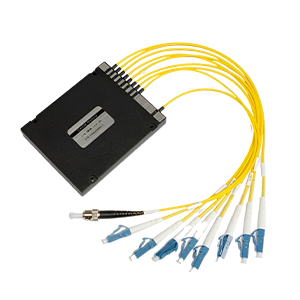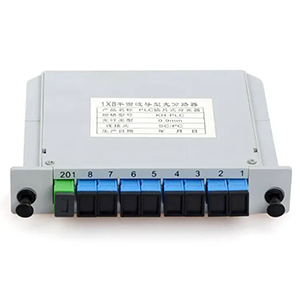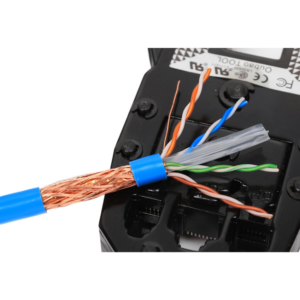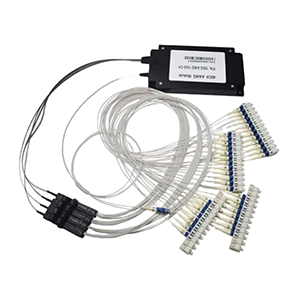5G networks have put forward new requirements for high-speed transmission. This article will focus on the application of fiber optic trunk cables in 5G networks. We will first outline the main technical features of 5G networks, such as ultra-high speed and low latency, and analyze the new requirements for transmission network infrastructure in 5G network construction. We will explain the key role of fiber optic trunk cables in 5G networks, including providing high-bandwidth transmission, achieving low-latency connections, ensuring transmission reliability, and providing flexible network topology.
Subsequently, we will provide suggestions for selecting suitable fiber optic trunk cables based on the coverage of 5G networks, and explain the precautions for installation and maintenance. Finally, we will analyze the mutually reinforcing relationship between 5G networks and the technological progress of fiber optic trunk cables, and look forward to the new requirements for fiber optic trunk cables in the evolution of 5G networks.
Key Technical Features of 5G Networks
Let me give you an overview of the key technical features of 5G networks and the new requirements for transmission network infrastructure.
Main technical features of 5G network:
(1) Ultra-high-speed transmission
- The download speed of 5G network can reach more than 10Gbps
- Greatly improve the transmission bandwidth of mobile Internet
(2) Ultra-low latency
- 5G network achieves end-to-end latency less than 10ms
- Provide high responsiveness for real-time interactive applications
(3) Massive connections
- 5G network can support 1 million device connections per square kilometer
- Meet the needs of massive terminal access in the era of the Internet of Things
(4) Ultra-reliability
- 5G networks have high redundancy and self-healing capabilities
- Ensure the continuity and reliability of key business applications
(5) Network slicing
- 5G supports on-demand customized network slicing functions
- Meet the personalized service needs of different industry applications
In short, with the above technical features, 5G networks have comprehensively improved the performance and experience of mobile communications.
New requirements for transmission network infrastructure in 5G network construction:
(1) Transmission bandwidth requirements have increased significantly
- 5G networks that support ultra-high-speed transmission require larger transmission bandwidth
- This poses new challenges to the performance of optical fibers and equipment that carry the network
(2) More stringent latency performance requirements
- 5G ultra-low latency characteristics require higher latency performance of the transmission network
- Network topology and transmission technology need to be optimized to reduce latency
(3) Enhanced network flexibility and adaptability
- 5G network slicing requires high flexibility of the transmission network
- Requires network resources to be dynamically allocated and orchestrated
(4) Higher requirements for reliability and security
- 5G key business applications have higher requirements for network reliability and security
- Transmission networks need to take measures such as redundant backup and enhanced security protection
Therefore, 5G network construction has put forward new requirements for the technical indicators and functional characteristics of the transmission network, and in-depth technical innovation and network optimization are required.
The role of optical fiber trunk cables in 5G networks
Let me analyze the important role of optical fiber trunk cables in 5G networks in detail.
Provide high-bandwidth transmission:
- Fiber-optic trunk cables have ultra-high transmission bandwidth, which can reach Tbit/s level
- This fully meets the needs of 5G networks for large-capacity data transmission
- Support 5G networks to carry massive voice, video, IoT and other services
Achieve low-latency connection:
- Fiber-optic transmission media has extremely low signal propagation delay
- This is completely consistent with the requirements of 5G networks for ultra-low latency
- Ensure the real-time and reliability of critical time-sensitive applications
Ensure transmission reliability: /h3>
- The fiber backbone network has excellent stability and anti-interference capabilities
- It can maintain continuous and stable transmission even in harsh environments
- Ensure the continuity and reliability of 5G key business applications
Provide flexible network topology:
- The fiber backbone network is easy to deploy and reconstruct network topology
- Support 5G network to dynamically adjust and optimize deployment according to demand
- Improve the flexibility and adaptability of 5G network
In short, the advantages of fiber backbone cables in bandwidth, latency, reliability and network flexibility fully meet the key technical requirements of 5G network construction. As the basic support of 5G network, fiber backbone cables play an indispensable and important role.
Deployment considerations for fiber-optic backbone cables in 5G networks
Let me give you a detailed introduction to the deployment considerations for fiber-optic backbone cables in 5G networks.
Choose appropriate fiber optic trunk cables according to 5G network coverage:
(1) Urban macro base station coverage
- Select high-density, high-core fiber optic trunk cables
- Meet the needs of large-capacity, high-speed transmission
(2) Suburban micro base station coverage
- Select medium-density fiber optic trunk cables
- Ensure coverage according to base station distribution
(3) Rural wide coverage area
- Select low-density, long-distance fiber optic trunk cables
- Meet the requirements of wide geographical coverage
Key points for installation and maintenance of fiber optic trunk cables:
(1) Rationally plan the fiber optic line
- Make full use of existing pipeline and conduit resources
- Choose a safe and interference-free line direction
(2) Strictly control the construction process
- Ensure the quality of fiber splicing and reduce attenuation
- Take appropriate protective measures to avoid mechanical damage
(3) Pay attention to daily maintenance
- Regularly check the fiber status and deal with problems in a timely manner
- Take preventive maintenance to improve system reliability
(4) Quickly respond to fault handling
- Establish a complete fault monitoring and rapid maintenance mechanism
- Minimize the network fault recovery time
(5) Consider future network expansion
- Reserve sufficient fiber backup capacity
- Support dynamic deployment and upgrade of 5G network
In summary, fiber trunk cable deployment should be reasonably planned according to the coverage requirements of 5G network, and effective installation and maintenance measures should be taken to ensure the high performance and reliability of 5G network.
Cooperative development of 5G network and fiber trunk cable
Let me analyze the cooperative development relationship between 5G network and fiber trunk cable, as well as the new requirements for fiber trunk cable put forward by the future evolution of 5G network.
The mutually reinforcing relationship of technological progress:
(1) 5G network promotes the upgrade of fiber optic trunk cable
- 5G network has high requirements for bandwidth, latency and reliability
- This forces the continuous advancement and innovation of fiber optic trunk cable technology
- Thereby improving the overall performance of the fiber optic backbone network
(2) Fiber optic trunk cable supports the development of 5G network
- The high bandwidth and low latency characteristics of the fiber optic backbone network
- Provide the basis for the large-capacity and low-latency applications of 5G network
- Ensure the high-quality connection experience of 5G network
It can be said that 5G network and fiber optic trunk cable are in a virtuous cycle of mutual promotion. The technological progress of both parties promotes each other and jointly promotes the continuous upgrading and optimization of communication networks.
New requirements for fiber backbone cables in the evolution of 5G networks:
(1) Higher transmission capacity requirements
- With the continuous growth of the number of 5G users and business volume
- The transmission capacity of the fiber backbone network needs to be continuously expanded
(2) Lower transmission delay requirements
- In the future, the requirements for delay performance of 5G networks will become more stringent
- The fiber backbone network needs to optimize the transmission path and transmission technology
(3) Stronger network flexibility
- 5G network slicing function requires flexibility in network topology
- The fiber backbone network needs to have the ability to quickly deploy and reconfigure
(4) Higher reliability guarantee
- Key 5G services have higher requirements for network continuity and availability
- Fiber-optic backbone networks need to take more reliable redundant backup measures
In short, with the continuous evolution of 5G network technology and the expansion of application scenarios, fiber-optic backbone cables will face higher performance and functional requirements, and continuous innovation and upgrading are needed to meet the development needs of 5G networks.
Summary
Fiber-optic backbone cables play an important role in supporting the construction of high-performance 5G networks. Our company has long been focusing on the research and development and production of optical communication equipment and its supporting products, and has rich industry experience. The various types of fiber-optic backbone cable products we provide have reached the industry-leading level in terms of transmission performance and reliability, and can meet your demanding needs for flexible and efficient 5G network construction.
Whether you need to deploy fiber-optic backbone cables in 5G base station coverage, backbone transmission, or edge computing nodes, we can provide you with customized solutions. At the same time, our professional team will provide you with a full range of technical support, including on-site survey, solution design, equipment installation and maintenance, etc. Contact us now to learn more about the application of optical fiber trunk cables in 5G networks.
Fiber Backbone Cable FAQ
A fiber backbone cable is a high-capacity, long-distance optical fiber cable that forms the core transport network infrastructure.
Fiber backbone provides the high-bandwidth, low-latency connectivity required to interconnect 5G cell sites, core network nodes, and cloud infrastructure.
Fiber offers virtually unlimited capacity, extremely low latency, and immunity to electromagnetic interference – crucial for 5G’s performance requirements.
Both single-mode and multi-mode fiber are deployed, with single-mode fiber being the predominant choice for long-haul 5G backhaul.
The fiber backbone allows 5G small cells and macrocells to be densely distributed while maintaining the necessary network connectivity.
Fiber’s high capacity supports the transport of virtualized network functions and cloud-based 5G core services.
Fiber links the 5G radio sites to aggregation and core network nodes, providing the high-speed transport for user data and control signaling.
Challenges include the high cost of fiber buildout, right-of-way access, and the need for fiber redundancy for network reliability.
Urban 5G may leverage existing fiber infrastructure, while rural 5G often requires new fiber backbone construction.
Advancements like wavelength-division multiplexing, hollow-core fiber, and software-defined networking are improving 5G fiber backbone performance.





